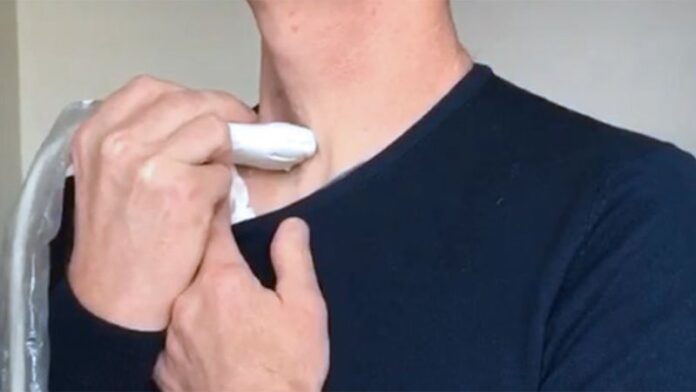[ad_1]
An investigational elastography technique for evaluating thyroid nodules while individuals use their voice could improve the detection of malignant tumors, which are sometimes missed by ultrasound and fine-needle aspiration biopsy, say French researchers. However, it has not yet been tested for cancer detection.
The new approach involves holding a linear ultrasound probe to the throat of the patient, who is then requested to vocalize an “eee” sound at 150 Hz. A loudspeaker plays a 150-Hz sound to guide the patient.
The vocal vibrations generated, called shear waves, are detected by the probe as they pass through the thyroid. Software that the researchers developed calculates the velocity of the shear waves, which move faster through stiffer tissue. The software produces a stiffness map that is then superimposed onto a gray-scale (B mode) thyroid image from the ultrasound.
Cancerous tissue is stiffer than healthy tissue and benign nodules, so shear waves pass through it more quickly, the researchers explain. Areas of particular stiffness that are revealed by the test are a concern.
The study was published online January 12 in Applied Physics Letters.
The new approach is a noninvasive method that “would reduce the stress of patients during their medical exams. Having to sing during a medical exam can perhaps help release some of the nervous tension even more,” lead investigator Steve Beuve, PhD, of the Université de Tours, Tours, France, said in a press release. The main benefit of this technique is that it is “quick and easy,” he added. Data acquisition takes about a second, and no specialized equipment is required. Imaging can be rendered by any Doppler ultrasound set at an ultrafast frame rate to track the shear waves. The computer program automatically calculates wave velocity through various parts of the thyroid.
The technique, dubbed vocal passive elastography (VPE), has not yet been tested to see how well it distinguishes cancerous from benign thyroid nodules.
“We want to cooperate with physicians to propose protocols to verify [VPE’s] relevance,” Beuve said.
Because no data are currently available on how accurate VPE is in diagnosing malignant nodules, it is not possible to comment on its potential usefulness, Aya Kamaya, MD, a radiology professor at Stanford University Medical Center, Stanford, California, told Medscape Medical News.
Ultrasound elastography for diagnosing thyroid disease has been in development for years. More than 100 reports have been published in the medical literature since 2005. Various devices are available commercially, but for now, elastography for thyroid nodules remains investigational, she said.
Another expert who was approached for comment was more critical.
Lisa Orloff, MD, a professor and director of endocrine head and neck surgery at Stanford, who is also director of the Stanford Thyroid Tumor Program, noted that in general, “Elastography has not gained more traction in thyroid evaluation to date because it does not appear to reduce the need for [fine-needle aspiration] of suspicious nodules based on gray-scale ultrasound alone, without elastography.”
As for the French report, she said that “while the voice might be a convenient shear wave source, I am very skeptical at many levels. I get the impression that [this is] a laboratory-based concept that is fraught with confounding factors in attempting real-world application.
“One concern is that the thyroid gland and nodule stiffness are affected by factors including underlying goiter, autoimmune disease, fluid content of nodules, calcifications, and other variables that can be present in benign or malignant conditions. And there are so many variables that would affect an individual patient’s ability (or not) to phonate at 150 Hz,” Orloff said.
VPE is an extension of passive elastography, which extracts elasticity data from the natural vibrations caused by the heart, blood pulsatility, and muscle activity, the authors explain. The team turned to vocalization at 150 Hz in part to overcome the physiologic background noise in the thyroid from carotid pulsation at about 1 to 10 Hz.
The group is exploring vocalizations at other frequencies and is working to improve the computer program interface. They are also exploring VPE for other organs, including the brain.
The source of funding for the study and the authors’ relevant financial relationships were not reported.
Appl Phys Lett. Published online January 12, 2021. Full text
M. Alexander Otto is a physician assistant with a master’s degree in medical science, and an award-winning medical journalist who has worked for several major news outlets before joining Medscape, including McClatchy and Bloomberg. He is an MIT Knight Science Journalism fellow. Email: [email protected].
For more from Medscape Oncology, join us on Twitter and Facebook.
[ad_2]
Source link












